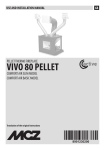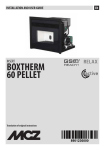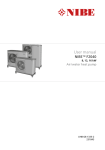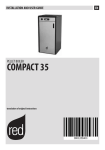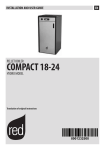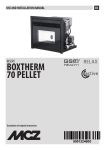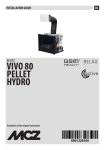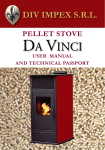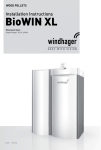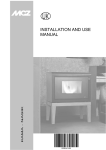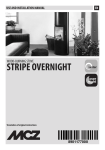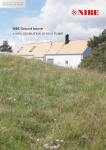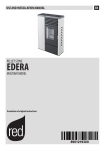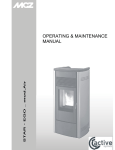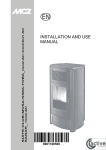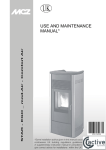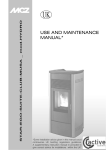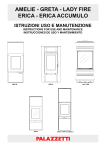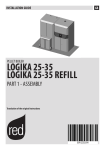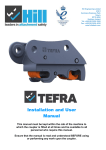Download Mcz Tube Wood pellet boiler manual
Transcript
INSTALLATION GUIDE EN PELLET STOVE TUBE COMFORT-AIR NuTech Renewables Ltd Unit 11, Warrenpoint Enterprise Centre Newry Road, Warrenpoint Co.Down, BT34 3LA Tel: + 44 28 417 53031 Email: [email protected] www.nutechrenewables.com Translation of original instructions TABLE OF CONTENTS INTRODUCTION...........................................................................................................1 1-WARNINGS AND WARRANTY CONDITIONS..................................................................3 2-INSTALLATION INSTRUCTIONS...................................................................................6 3-INSTALLATION AND ASSEMBLY................................................................................14 4-OPERATION............................................................................................................25 5-LCD REMOTE CONTROL............................................................................................27 6-EMERGENCY PANEL.................................................................................................32 7-SAFETY DEVICES AND ALARMS.................................................................................35 8-MAINTENANCE AND CLEANING................................................................................39 9-PROBLEMS/CAUSES/SOLUTIONS..............................................................................44 10-WIRING DIAGRAMS...............................................................................................47 II INTRODUCTION Dear Customer, Thank you for having chosen our product. To allow for optimal operation and for you to enjoy the warmth and sense of wellbeing that the fire can convey in your home, we advise you to read this manual carefully before starting up the product for the first time. REVISIONS TO THE PUBLICATION The content of this manual is strictly technical and property of MCZ Group Spa. No part of this manual can be translated into another language and/or altered and/or reproduced, even partially, in another form, by mechanical or electronic means, photocopied, recorded or similar, without prior written approval from MCZ Group Spa. The company reserves the right to make changes to the product at any time without prior notice. The proprietary company reserves its rights according to the law. CARE OF THE MANUAL AND HOW TO CONSULT IT • • • • • Take care of this manual and keep it in an easily accessible place. Should the manual be misplaced or ruined, request a copy from your retailer or directly from the authorised Technical Assistance Department. “Bold text” requires particular attention. “Text in “italics” is used to draw your attention to other paragraphs in this manual or any additional explanation. “NOTE” provides the reader with additional information. Technical Dept. - All rights reserved - Reproduction is prohibited 1 INTRODUCTION SYMBOLS USED IN THE MANUAL ATTENTION: carefully read and understand the relative message because failure to comply with that which is written can cause serious damage to the product and put the user’s safety at risk. INFORMATION: failure to comply with these provisions will compromise the use of the product. OPERATING SEQUENCES: sequence of buttons to be pressed to access the menus or make adjustments. MANUAL carefully read this manual or the relative instructions. 2 1-WARNINGS AND WARRANTY CONDITIONS SAFETY PRECAUTIONS • • • • • • • • • • • • • • • • • • • • • • • • • Installation, electrical connection, functional verification and maintenance must only be performed by qualified or authorised personnel. Install the product in accordance with all the local and national laws and Standards applicable in the relative place, region or country. This product is not intended for use by persons (including children) with reduced physical, sensory or mental capabilities, or lack of experience and knowledge, unless they are supervised or trained on how to use the product by a person responsible for their safety. Only fuel recommended by the company must be used. The product must not be used as an incinerator. It is strictly forbidden to use liquid fuel. The instructions provided in this manual must always be complied with to ensure the product and any electronic appliances connected to it are used correctly and accidents are prevented. The user, or whoever is operating the product, must read and fully understand the contents of this installation guide before performing any operation. Errors or incorrect settings can cause hazardous conditions and/or poor operation. Do not use the product as a ladder or supporting structure. Do not place laundry on the product to dry. Any clothes horses or similar objects must be kept at a safe distance from the product. Fire hazard. All liability for improper use of the product is entirely borne by the user and relieves the Manufacturer from any civil and criminal liability. Any type of tampering or unauthorised replacement with non-original spare parts could be hazardous for the operator's safety and relieves the company from any civil and criminal liability. Most of the surfaces of the product can get very hot (door, handle, glass, smoke outlet pipes, etc.). Avoid contact with these parts unless adequate protective clothing is worn or appropriate means are used, such as heat protective gloves or cold handles. It is forbidden to operate the product with the door open or the glass broken. The product must be powered by a system that is equipped with an effective earth system. Switch the product off in the event of a fault or malfunctioning. Accumulated unburned pellets in the burner after each "failed start-up" must be removed before starting up again. Do not wash the product with water. Water could penetrate the unit and damage the electrical insulation, thereby causing electric shocks. Do not stand in front of the product for a long time. Do not overheat the room where the product is installed. This could affect your physical conditions and cause health problems. Do not put any fuel other than wood pellets in the hopper. Install the product in rooms that are adequately protected against fire and equipped with all the utilities such as supplies (air and electricity) and smoke outlets. If a fire breaks out inside the chimney, switch the appliance off, disconnect it from the mains and do not open the door. Then contact the competent authorities. The product and the ceramic/serpentine cladding must be stored in a place where there is no humidity and must not be exposed to the elements. It is recommended not to remove the feet that support the product in order to guarantee adequate insulation, especially if the flooring is made of flammable material. If the ignition system is faulty, do not force ignition with flammable materials. Special maintenance must only be performed by authorised and qualified personnel. Assess the static conditions of the surface on which the weight of the product will rest and provide suitable insulation if it is made of flammable material (e.g. wood, fitted carpet or plastic). Technical Dept. - All rights reserved - Reproduction is prohibited 3 1-WARNINGS AND WARRANTY CONDITIONS INFORMATION: Please contact the retailer or qualified personnel authorised by the company to resolve a problem. • only fuel stipulated by the company must be used. • Check and clean the smoke outlet pipes regularly (connection with the product). • The product is not a cooking appliance. • Always keep the cover of the fuel hopper closed. • Keep this instruction manual in a safe place as it must accompany the product throughout its working life. If it is sold or transferred to another user, always make sure that the manual accompanies the product. INTENDED USE The product only works with wood pellets and must be installed indoors. WARRANTY CONDITIONS The company provides a product warranty, excluding the parts subject to normal wear stipulated below, for a period of two years from the date of purchase, which is proven by a supporting document that contains the name of the seller and the date when the sale took place. Warranty cover is valid if the completed warranty is returned within 8 days and the product is installed and tested by a qualified installer, according to the detailed instructions provided in the instruction manual supplied with the product. The term ‘warranty’ refers to the (free-of-charge) replacement or repairs of parts acknowledged to be faulty due to manufacturing defects. RESTRICTIONS The above-mentioned warranty does not cover parts of electrical and electronic components and fans, which are covered for 1 year from when the product is purchased, proof of which is provided as specified above. The warranty does not cover parts subject to normal wear, such as: gaskets, glass and all parts that can be removed from the firebox. Replaced parts will be covered by the warranty for the remaining period of the warranty in force as from the date of purchase of the product. EXCLUSIONS Variations in colour of the painted or ceramic/serpentine parts and crazed ceramics do not constitute grounds for a claim as they are natural characteristics of the material and product use. The warranty does not cover any part that may be faulty as a result of negligence or careless use, incorrect maintenance or installation that does not comply with the company's instructions (see the relative chapters in this user manual). The company declines all liability for any damage which may be caused, directly or indirectly, to persons, animals or objects as a consequence of non compliance with all the prescriptions specified in the manual, especially warnings regarding installation, use and maintenance of the appliance. If the product does not work correctly, contact your local retailer and/or importer. Damage caused during transport and/or when handled is excluded from the warranty. The supplied installation guide is the only reference for installation and product use. The warranty will be rendered null and void in the event of damage caused by tampering, atmospheric agents, natural disasters, electrical discharges, fire, defects in the electrical system, and maintenance not being performed at all or as indicated by the manufacturer. 4 1-WARNINGS AND WARRANTY CONDITIONS INTERVENTION REQUEST The company declines all liability if the product and any other accessory is used incorrectly or altered without authorisation. All parts must be replaced with original spare parts. The request must be sent to the retailer who will forward it to the Technical Assistance Department. SPARE PARTS Only original spare parts must be used. The retailer or service centre can provide all the useful information regarding spare parts. It is recommended not to wait for the parts to be worn before having them replaced. It is important to perform regular maintenance. PRECAUTIONS FOR CORRECT DISPOSAL OF THE PRODUCT IN ACCORDANCE WITH THE EUROPEAN DIRECTIVE 2002/96/EC AND ITS SUBSEQUENT AMENDMENT 2003/108 EC. At the end of its working life, the product must not be disposed of as urban waste. It must be taken to a special differentiated waste collection centre set up by the local authorities or to a retailer that provides this service. Disposing of the product separately prevents possible negative consequences for the environment and health deriving from inappropriate disposal and allows its materials to be recovered in order to obtain significant savings in energy and resources. As a reminder of the need to dispose of appliances separately, the product is marked with a crossed-out wheeled dustbin. Technical Dept. - All rights reserved - Reproduction is prohibited 5 2-INSTALLATION INSTRUCTIONS The requirements in this chapter refer to the regulations of the Italian installation Standard UNI 10683. In any case, always comply with the regulations in force in the country of installation PELLETS Wood pellets are manufactured by hot-extruding compressed sawdust which is produced during the working of natural dried wood. The compactness of the material is guaranteed by the lignin contained in the wood itself and allows pellets to be produced without glue or binders. The market offers different types of pellets with characteristics that vary according to the wood mixtures used. The diameter varies between 6 and 8 mm, with a standard length ranging from 5 to 30 mm. Good quality pellets have a density that varies between 600 and over 750 kg/m3, with a moisture content that ranges from 5% to 8% of its weight. Pellets have technical advantages besides being an ecological fuel, as the wood residue is used completely, thereby achieving cleaner combustion than that of fossil fuels. Good-quality wood has a calorific value of 4.4 kW/kg (15% moisture, after about 18 months of seasoning), whereas that of pellets is 4.9 kW/kg. To ensure good combustion, the pellets must be stored in a dry place and protected from dirt. Pellets are usually supplied in 15 kg bags, therefore, storing them is very convenient. Good quality pellets guarantee good combustion, thereby decreasing harmful emissions into the atmosphere. 15 Kg BAGS OF FUEL The poorer the quality of the fuel, the more often the internal parts of the brazier and combustion chamber must be cleaned. DINplus, Ö-Norm M7135 and Pellet gold are examples of the major quality certifications of pellets in the European market and guarantee that the following are complied with: • • • • • • • calorific value: 4.9 kWh/kg. Moisture content: max 10% of the weight. Percentage of ash: max 0.5% of the weight. Diameter: 5 – 6 mm. Length: max 30 mm. Content: 100% untreated wood with no added binding agents (max percentage of bark: 5%). Packaging: in bags made from environmentally friendly or biologically decomposable material. The company strongly recommends using certified fuel for its products (DINplus, Ö-Norm M7135 or Pellet Gold). Poor quality pellets or others that do not comply with that specified previously compromises the operation of your product and can therefore render the warranty and product liability null and void. 6 2-INSTALLATION INSTRUCTIONS PRECAUTIONS REGARDING INSTALLATION IMPORTANT! Product installation and assembly must be carried out by qualified personnel. The product must be installed in a suitable place for it to be regularly opened and routine maintenance to be performed. The site must be: • compliant for proper operation. • Equipped with an adequate smoke expulsion system. • Equipped with ventilation intake from outside. • Equipped with 230V 50 Hz power supply with an EC compliant earth system. The product must be connected to a chimney or an internal or external vertical duct that complies with current regulations. The product must be positioned in such a way that the electrical socket is accessible. IMPORTANT! The product must be connected to a chimney or a vertical duct that can expel the smoke at the highest point of the building. The smoke derives from the combustion of wood essence and if it comes in contact with or close to walls, the latter can become dirty. Moreover, utmost attention is required as they are almost invisible but very hot and can cause burns. The holes of the external air inlet and the smoke outlet pipe must be drilled before positioning the product. THE OPERATING ENVIRONMENT For correct operation and even distribution of heat, the product must be placed where the air required for combustion can flow. The volume of the room should be no less than 3 m3. The air must enter through permanent openings in the walls (near the product) that reach outside with a minimum section of 100 cm2 without the protective grille (in the case of a non-Oyster installation, i.e. without external ducted combustion air. These openings (air inlets) must be made in such a way that it is impossible for them to be obstructed in any way. Air can also be drawn from adjacent rooms to the one that is to be ventilated, provided they have an external air inlet and are not used as a bedroom or bathroom or where there is a fire hazard, such as: a garage, wood shed or where flammable materials are stored, and applicable regulations must be strictly complied with. If the product is placed too close to the wall it could cause overheating and damage the plaster (yellowing, cracking, etc.). Technical Dept. - All rights reserved - Reproduction is prohibited 7 2-INSTALLATION INSTRUCTIONS POSITIONING AND RESTRICTIONS In the case of simultaneous installation with other heating appliances, provide appropriate air inlets for each one (according to the instructions of each product). The product cannot be installed (except for sealed or closed operation appliances with external ducted combustion air intake): • in bedrooms or bathrooms; • in rooms where there are liquid fuel appliances with continuous or intermittent operation that draw the combustion air from the room they are installed in; • in rooms where there are B-type gas heating appliances, with or without domestic hot water production and interconnecting rooms; • where another heating appliance is installed without an independent air flow. It is forbidden to place the product in an explosive atmosphere. MINIMUM DISTANCES Room ventilation can only be set towards the rear wall if there is adequate insulated ducting of the hot air flow. TUBE Comfort Air model Non-flammable walls A = 15 cm B = 15 cm Flammable walls A A = 20 cm B = 20 cm B If particularly delicate objects are present, such as furniture, curtains or sofas the distance of the product must be significantly increased. If the floor is made of wood, it is recommended to place a floor protection in accordance with the Standards in force in the country of installation. Heat-sensitive or flammable objects cannot be placed near the product. Keep such objects at a minimum distance of 80 cm from the outermost point of the product. 8 2-INSTALLATION INSTRUCTIONS CONNECTION OF THE SMOKE EXHAUST DUCT When drilling the hole for the smoke exhaust pipe, the possible presence of flammable materials must be considered. If the hole must be made through a wooden wall or thermolabile material, the INSTALLER MUST first use the relative wall fitting (minimum diam. 13 cm) and adequately insulate the pipe of the product that passes through it, using suitable insulating material (1.3 - 5 cm thick with minimum thermal conductivity 0.07 W/m°K). The same minimum distance must be applied if the pipe of the product must pass through vertical or horizontal sections near the thermolabile wall. It is recommended to use an insulated double-wall pipe in external sections in order to prevent condensation from forming. The combustion chamber works in negative pressure. 2 1 1 - SMOKE OUTLET 2 - COMBUSTION AIR INLET Technical Dept. - All rights reserved - Reproduction is prohibited 9 2-INSTALLATION INSTRUCTIONS Always use pipes and fittings with appropriate seals that guarantee tightness. It must be possible to inspect all sections of the flue duct and they must be removable for periodic internal cleaning (T-fitting with inspection hole). Position the product considering all the above requirements and instructions. IMPORTANT! The following conditions must be complied with when connecting the appliance to the chimney: • the smoke duct must be at least category T200 (or higher if required by the smoke temperature of the appliance) and P1-type (airtight). • All 90° angles (max. 3) in the smoke exhaust duct must be preferably fitted with the relative T-fittings with inspection hole. (See pellet product accessories). • It is strictly forbidden to fit a mesh at the end of the exhaust pipe as it could cause the product to malfunction (due to clogging). • It is forbidden to use counter-sloping pipes. • The horizontal section of the smoke duct must not be longer than 2-3 m. • It is also recommended not to exceed 6 metres in length with the pipe Ø 80 mm. • The smoke duct must not cross rooms in which it is forbidden to install combustion appliances. COMBUSTION AIR (2) During operation a certain amount of air is drawn from the room in which the product is installed and this air must be supplemented through an external air inlet. 10 2-INSTALLATION INSTRUCTIONS CONNECTION TO THE EXTERNAL AIR INLET It is essential for the room where the product is installed to be adequately ventilated in order to guarantee sufficient air for proper combustion in the appliance. This is possible by means of suitable ventilation openings in the room itself or in an interconnected room through a permanent opening between the rooms (room ventilation is excluded in the case of installation with Oyster technology, where combustion air is ducted directly from outside) For this purpose, drill a hole on the outer wall close to the product with a minimum section of 80 cm² (11 cm in diameter or 10x10 cm if rectangular, considering the protective grids), protected by a grid on the outside. The air inlet must also: • be protected with a grid, metal mesh, etc. without reducing the net section. • Be positioned in such a way so as not to be obstructed. • Allow maintenance to be performed. • Be directly interconnected with the room where the product is installed. • In the case of ducting, up to 3.5 linear metres, increase the cross-section by about 5%, whereas for longer ducts, increase it by 15%. Remember that the ventilation grilles always have a useful section in cm2 on one side. When choosing the grille and size of the hole, check that the useful section of the grille is larger or equal to the section required by the company for product operation. IMPORTANT! The air flow can also be drawn from an adjacent room to that of the room where the product is installed, provided the air can flow freely through permanent openings interconnected with the outside; air inlets connected to thermal units, garages, kitchens or bathrooms must be avoided. CONNECTION TO THE CHIMNEY The chimney is the fundamental element for smoke expulsion and must therefore comply with the following requirements: • be waterproof and thermally insulated. • Be made of suitable materials that resist mechanical stress over time, heat, the effects of the combustion products and any possible condensation. • Have a vertical set-up with deviations from the axis of no more than 45° and free of bottlenecks. • Must be suitable for the specific operating conditions of the product and have the CE marking (EN1856-1, EN1443). • Must be adequately sized for the draught/smoke expulsion requirements that are necessary for the product to operate correctly (EN13384-1). • The internal section is preferably circular. • In the case of a pre-existing product that has been used, it must be cleaned. The chimney is fundamental for correct operation and safety of your product. Hereunder are a few guidelines for a correct installation. Any alternative configurations must be suitably sized in accordance with the general method of calculation of UNI EN 13384-1. Technical Dept. - All rights reserved - Reproduction is prohibited 11 2-INSTALLATION INSTRUCTIONS CONNECTIONS CONNECTION TO THE CHIMNEY CONNECTION TO AN EXTERNAL DUCT WITH AN INSULATED OR DOUBLE-WALL PIPE CONNECTION TO THE CHIMNEY The internal dimensions of the chimney must not exceed 20x20 cm or 20 cm in diameter. In the case of larger dimensions or bad chimney conditions (e.g. cracks, poor insulation, etc.), it is advisable to fit a stainless steel pipe of suitable diameter throughout the length of the chimney right to the top. The minimum internal dimensions of the external duct must be 10x10 cm or 10 cm in diameter and must not exceed 20x20 cm or 20 cm in diameter. Only stainless steel insulated (double-wall) pipes must be used, which are smooth on the inside and fixed to the wall. Flexible stainless steel pipes must not be used. The connection between the product and the chimney or the smoke duct must not have an inclination that is less than 3% in the horizontal sections, which must have a maximum overall length of 2/3 m. The vertical section between one T-fitting and another (angle) must not be less than 1.5 m. mt.0,5 mt.0,5 mt. 1 1 1 0,5 mt.0,5 mt.0,5 mt. 1 1 1 0,5 mt.0,5 mt.0,5 mt. 1 2 - 3 mt. 2 -MAX 3 mt. 2 - MAX 3 mt. MAX 1) WINDPROOF CHIMNEYPOT • • • • • 12 2) CHIMNEY 3 2 3 2 3 2 3 2 2 3 3 3-5 % 3-5 % 3-5 % H > 1,5 mt. 3 2 H > 1,5 mt. 3 2 H > 1,5 mt. 2 1 3) INSPECTION HOLE Use adequate instruments to verify that there is a minimum draught of 5 Pa. Set-up an inspection hole at the bottom of the chimney to perform periodic checks and cleaning, which must be done annually. The connection to the chimney must be sealed and the fittings and pipes recommended by us must be used (CE marked in accordance with EN1856-2 with the minimum requisites: T200 and P1). You must ensure that a windproof chimneypot is installed in accordance with the regulations in force. This type of connection guarantees smoke expulsion even in the event of a temporary power cut. 1 3 2-INSTALLATION INSTRUCTIONS OPERATING PROBLEMS RELATED TO DRAUGHT DEFECTS IN THE CHIMNEY Among all the weather and geographical conditions that affect chimney operation (rain, fog, snow, altitude a.s.l., exposure to sunlight, orientation to the cardinal points, etc.), the wind is certainly the most determinant. In fact, besides the thermal depression caused by the difference in temperature between inside and outside the chimney, there is another type of depression (or overpressure): dynamic pressure caused by the wind. An updraft always increases depression and therefore the draught. A horizontal wind increases depression provided the chimneypot has been installed properly. A downdraft always decreases depression, at times inverting it. A B A=LESS FAVOURABLE POINTS B=THE MOST FAVOURABLE POSITION Besides the direction and force of the wind, the position of the chimney and the chimneypot with respect to the roof of the building and the surrounding landscape is also important. The wind also affects chimney operation indirectly by creating overpressure and depression zones within the building as well as outside. An internal overpressure can be created in rooms that are directly exposed to the wind (2), which can enhance the draught in stoves and fireplaces, however, it can be counteracted by the external overpressure if the chimneypot is situated on the side exposed to the wind (1). On the other hand, a dynamic depression can be created in rooms that are opposite the wind direction (3), which competes with the natural thermal depression generated by the chimney, however, this can be compensated for (sometimes) by placing the smoke duct opposite the wind direction (4). IMPORTANT! The operation of the pellet product is significantly affected by the chimney layout and position. Hazardous conditions can only be resolved by qualified personnel setting the product appropriately. WIND 1 4 2 Technical Dept. - All rights reserved - Reproduction is prohibited 3 13 3-INSTALLATION AND ASSEMBLY DRAWINGS AND CHARACTERISTICS 573 1192 267 44 TUBE DIMENSIONS COMFORT AIR MODEL 8 24 382 402 547 595 614 73 520 298 14 Ø80 245.5 425.8 267 Ø4 322 198 3-INSTALLATION AND ASSEMBLY TECHNICAL CHARACTERISTICS TUBE - COMFORT AIR model Type of fuel Pellets Nominal thermal power 8 kw / 6,880 kcal Minimal thermal power 2.4 kw / 2,064 kcal Efficiency at Max 91,7% Efficiency at Min 94,1% Temperature of exhaust smoke at Max 170 ℃ Temperature of exhaust smoke at Min 100 °C Particulate/OGC/Nox (13%O2) 22 mg/Nm3 - 6 mg/Nm3 - 121 mg/Nm3 (13% O2) CO at 13% O2 at Min and at Max 0,025 – 0,014% CO2 at Min and at Max 5,7% - 8,7% Recommended draught at Max power 0.10 mbar - 10 Pa Recommended draught at Min power 0.05 mbar - 5 Pa Mass of smoke at Min and at Max 4.0 - 6.6 g/sec Hopper capacity 32 litres Type of pellet fuel Pellet diameter 6-8 mm. and size 5/30 mm Pellet hourly consumption Min ~ 0.6 kg/h* - Max ~ 1.8 kg/h* Autonomy At min ~ 40 h* - At max ~ 13 h* Heatable volume m3 172/40 – 196/35 – 229/30 ** Combustion air inlet External diameter 50 mm Smoke outlet External diameter 80 mm Electrical power consumption Max 420 W - Med. 80 W Supply voltage and frequency 230 Volt / 50 Hz Net weight 130 kg Weight with packaging 140 kg * These data may vary according to the type of pellets used. ** Heatable volume based on the heat demand 40-35-30 m3 (respectively 40-35-30 Kcal/h per m3). Tested according to EN 37,553.90 cm accordance with Directive 89/106/EEC (Construction Products). The stove is an intermittent combustion appliance. Technical Dept. - All rights reserved - Reproduction is prohibited 15 3-INSTALLATION AND ASSEMBLY PREPARATION AND UNPACKING The Tube stove is delivered in a single package and the sides and the top are already fitted to the structure. Open the package, remove the four brackets (B) that block the product to the pallet by removing screws (A) and extracting the bracket (B) from under the feet "J" of the stove. Set the product in the pre-selected place, making sure this complies with the requirements. EXAMPLE OF THE STOVE PACKAGING REMOVING THE PACKAGING SCREWS A B B C J A - SCREW B - BRACKET C - PALLET J - FOOT 16 3-INSTALLATION AND ASSEMBLY The product must always remain in a vertical position and handled solely with a cart. Pay particular attention to the door and its glass, protecting them from mechanical knocks that would compromise their integrity. In any case, the product must always be handled with care. If possible, unpack the product near the place of installation. The packaging materials are neither toxic nor harmful, and therefore no particular disposal measures are required. Therefore, the end user is responsible for product storage, disposal or possible recycling in compliance with the relative applicable laws. Do not store the unit or the cladding without their packaging. Position the product and connect it to the chimney. If the product must be connected to an exhaust pipe that goes through the rear wall (to enter the chimney), make sure not to force it in. Adjust the 4 feet (J) to level the stove for the smoke exhaust and the pipe to be coaxial. The feet are adjusted by lifting the product slightly. Attention! Do not use and/or force the smoke exhaust pipe when handling the stove as it can be damaged. 1 FOOT J 1 - SMOKE OUTLET Technical Dept. - All rights reserved - Reproduction is prohibited 1. TURN THE FOOT CLOCKWISE TO LOWER THE STOVE 2. TURN THE FOOT ANTI-CLOCKWISE TO RAISE THE STOVE 17 3-INSTALLATION AND ASSEMBLY CONNECTING THE HOT AIR DUCTING FOR COMFORT AIR MODELS Once the product is set in place, the hot air piping can be installed. The COMFORT AIR stoves are supplied as standard with a hot air diffuser, which has an air diverter E within. Therefore, the hot air that comes out from the rear flange of the stove meets this diverter inside the diffuser E and is then directed to the right and left of the room; this occurs when the hot air is not channelled. If the hot air is to be channelled, remove the diffuser E, connect the soundproof fitting F (optional) that turns the outlet shape from square to round and then connect the various connections with the special pipes and fittings of the manufacturer that divert the flow to a number of hot air diffusers (120x120 mm nozzle). These channels can also be walled in. (SEE OPTIONALS) The air outlet pipe can become very hot, approx. 200 °C: therefore, it must be adequately insulated with suitable material, especially points that could come in contact with flammable surfaces or parts that are affected by heat (e.g. change in shades, wiring ducts, plasterboard, etc.). Moreover, persons and animals must be protected from accidental or intentional contact. In any case, comply with the regulations and laws in force in the region where the product is installed. It is recommended to insulate the entire length of the pipe in order to reduce dispersion and increase heat output in the room. B C E D F A 18 A - STOVE B - HOT AIR OUTLET PIPE C - THROUGH-WALL D - INSULATION 3-INSTALLATION AND ASSEMBLY If the wall that is to be drilled through is made of flammable material, the INSTALLER MUST adequately insulate the pipe of the stove that passes through it, using suitable insulating material (1.3 - 5 cm thick with min. thermal conductivity 0.07 W/m°K). However, the pipe inserted in the wall must be adequately insulated in order not to disperse heat and soundproof the released air. It is advisable to set up the ducts of similar length to distribute the air evenly, otherwise it will go through the shorter channel or that with less windings. In the example in figure 6 and 7 (front and rear view), the air ducting is of equal length for a total of 8 metres, i.e. the pipes (B) will be approximately 4 metres each. If the pipes are of different length, the total must always add up to 8 metres (e.g. 3 + 5 metres). In this case, the heat will not diffuse into the rooms uniformly. The air recirculation in the room occurs through the perforated plate on the rear side of the stove. The air volume that you wish to exit from the upper and rear parts of the stove can be set separately by adjusting the ventilation power directly with the remote control. A A B B FIGURE 6 - FRONT VIEW OF THE SYSTEM AIR OUTLET B B FIGURE 7 - REAR VIEW OF THE SYSTEM AIR OUTLET REMOVING THE AIR DIFFUSER Diffuser E must be removed from the back panel of the stove if you wish to channel the air. Remove the two upper screws and extract diffuser E from the grooves. SCREW E E GROOVES Technical Dept. - All rights reserved - Reproduction is prohibited 19 3-INSTALLATION AND ASSEMBLY REMOVING THE CLADDING TOP Remove the top as follows: • lift cover L. • Remove cover M; remove the three screws that fasten the slide of cover M from the structure and extract plate G from T in cover L. • Remove the three screws X and then remove the cover completely. G L T M 20 M SLIDE 3-INSTALLATION AND ASSEMBLY LATERAL SIDES "O" Proceed as follows to remove the lateral sides O: • remove the two screws Y that block panel O to the structure. • Lift panel O for it come out of the pins on the lower part. • Repeat the same operation on the opposite panel. M L X X X Y Y O PINS Technical Dept. - All rights reserved - Reproduction is prohibited 21 3-INSTALLATION AND ASSEMBLY FRONT PANEL "P" After having removed the lateral sides, remove: • the two screws K on the right and left of the panel. • Lift the front panel P for it come out of the pins on the lower part of the stove. • Then set panel P aside, safely to prevent damaging it. K K P 22 PINS 3-INSTALLATION AND ASSEMBLY ELECTRICAL CONNECTION First connect the power cable on the rear side of the stove and then to a wall socket. The main switch on the rear side must only be activated when the stove is used; otherwise, it is advisable to keep it off. It is recommended to disconnect the power cable when the stove is not used. ASSEMBLING THE AIR FILTER The cylindrical filter is already fitted inside the stove. If it must be cleaned, slightly loosen the screw knob on the air inlet pipe, remove the filter, clean it and then set it and block it in place by tightening the knob. ATTENTION! The stove must never be operated without the air filter. The manufacturer cannot be held liable for any damage caused to the internal components if this requirement is not complied with. ASSEMBLING/REMOVING THE AIR FILTER OPENING/CLOSING THE DOOR The door is opened by inserting the cold handle on the opening hook of the door, lifting and pulling. ATTENTION! The door must be closed properly for the stove to work correctly. OPENING/CLOSING THE DOOR Technical Dept. - All rights reserved - Reproduction is prohibited 23 3-INSTALLATION AND ASSEMBLY BEFORE START-UP GENERAL PRECAUTIONS Remove all components that could burn from the brazier and the glass (manual, various adhesive labels and any polystyrene). Check that the brazier is positioned correctly and rests properly on the base. After a long period of inactivity, remove any pellets left in the hopper (using a vacuum cleaner with a long pipe), as they could have absorbed moisture, thereby altering their original characteristics and no longer being suitable for combustion. The first start-up may not be successful as the feed screw is empty and does not always manage to load the required amount of pellets in the brazier in time for the fire to be regularly ignited. CANCEL THE FAILED START-UP ALARM STATUS BY BRINGING SELECTOR “D” TO OFF. REMOVE THE PELLETS FROM THE BRAZIER AND REPEAT START-UP. (SEE THE "SAFETY DEVICES" PARAGRAPH) If a flame does not ignite after a number of failed start-ups, even though the pellet supply is correct, make sure the brazier is set in place correctly, which must be interlocked in its seat and clean from any ash deposits. If no anomaly is found during this inspection, there may be a problem with the product components or installation may not be correct. REMOVE THE PELLETS FROM THE BRAZIER AND CONTACT AN AUTHORISED TECHNICIAN. Avoid touching the stove during the initial start-up, as the paint hardens during this phase. If you touch the paint, the steel surface may be exposed. If necessary, touch up the paint with the spray can of the specific colour. (See "Pellet stove accessories") 24 4-OPERATION It is good practice to guarantee effective ventilation in the room during the initial start-up, as the stove will emit some smoke and smell of paint. Do not stand close to the stove and air the room. The smoke and smell of paint will disappear after about an hour of operation, however, they are not harmful in any case. The stove will be subject to expansion and contraction during the start-up and cooling phases, therefore light creaking noises may be heard. This is absolutely normal as the structure is made of laminated steel and must not be considered a defect. It is extremely important to make sure the stove is not immediately overheated and the temperature is increased gradually starting from the low power. This will prevent damaging the ceramic or serpentine tiles, the welds and the steel structure. DO NOT EXPECT HEATING EFFICIENCY IMMEDIATELY!!! SETTINGS TO BE CARRIED OUT BEFORE THE INITIAL START-UP Once the power cable is connected on the rear side of the stove, bring the switch to position (I). Switch the stove on and off by pressing key A on the remote control and LED B or C on the emergency panel will light up according to the mode of the stove. A Technical Dept. - All rights reserved - Reproduction is prohibited 25 4-OPERATION LOADING THE PELLETS Fuel is loaded from the upper part of the stove by opening the door. Pour the pellets into the hopper. This is easier if performed in two steps: • Pour half the contents into the hopper and wait for the fuel to settle at the bottom. • Then pour in the second half. Never remove the protective grille from inside the hopper. When loading pellets, prevent the bag from coming into contact with hot surfaces. No other type of fuel other then pellets, in compliance with above-mentioned specifications, is to be inserted into the hopper. Store the fuel at a safe distance. Do not pour the pellets directly on the brazier but only into the hopper. Most of the surfaces of the stove are very hot (door, handle, glass, smoke outlet pipes, hopper door, etc.). It is therefore recommended to avoid contact with these parts unless adequate protective clothing is worn. LIFT THE COVER INSERT THE PELLETS LOADING THE PELLETS 26 5-LCD REMOTE CONTROL B GENERAL SPECIFICATIONS OF THE LCD REMOTE CONTROL D control works at a transmission frequency of 434.5 MHz. The remote Power the product with 3 AAA batteries as follows: E • remove the cover of the battery compartment by pressing and lifting the point indicated by the arrow. • Insert the batteries with the correct polarity (+) and (-). • Close the cover of the battery compartment. The time must be set when the remote control is switched on. C when the batteries are almost flat. If the flat battery icon appears, the The remote control has a special icon on the display to indicate batteries are almost flat and the remote control is about to go off. Used batteries must be disposed of separately in special containers. GRAPHIC APPEARANCE Reference will often be made to the keys. Always keep the figure at hand for simplicity's sake. A B D E C Technical Dept. - All rights reserved - Reproduction is prohibited 27 5-LCD REMOTE CONTROL REMOTE CONTROL OPERATION GENERAL RULES Press key A for 1” to switch the product on and off. All changes are made with keys C. Key E is used to confirm the changes. Key B is used to select the product operating mode. Key D is used to browse the VENTILATION and SLEEP settings (see "Various settings"). Whichever the mode is, press key A briefly (or leave the keypad idle for 7”) to go back to the initial display. INITIAL SETTINGS SETTING THE TIME The time/day setting is accessed by pressing keys B+E simultaneously for 3”, regardless whether the remote control is on or off. The hour digits will start to flash, which can be modified with keys C. Press key E to confirm the changes. The minute digits will then start to flash. Follow the same procedure to modify and confirm the setting and the time display setting (12h or 24h) will then be accessed and lastly, the day will start to flash. Confirm this data to exit the settings. NOTE: each time the remote control is powered, the time is reset and the display automatically enters the time setting. °C -°F SETTING The unit of temperature measurement is changed from Celsius to Fahrenheit and vice versa by pressing key B for 5” while the product is off. SETTING THE OPERATING MODE One of the following 4 operating modes can be set via key B while the remote control is on. The 4 basic displays are shown, respectively, in figures 1-2-3 and 4: Manual, Automatic, Timer and Eco mode. MANUAL MODE (MAN) This mode allows the flame power (changed directly via keys C) and ventilation to be set manually in 5 levels + auto (see "Various settings"). Figure 1 AUTOMATIC MODE (AUTO) This mode allows the desired room temperature to be set and the appliance will automatically adjust the flame power to reach it. The ventilation can be adjusted in 5 levels + auto (see "Various settings"). Figure 2 TU 12:02 MAX FIGURE 1 MANUAL MODE. 28 TU 31 12:03 °C MAN °C 35 °C 31 AUTO FIGURE 2 AUTOMATIC MODE. 5-LCD REMOTE CONTROL TIMER MODE (TIMER) Select this operating mode to switch the product on and off automatically, according to 6 customised time bands (P1 – P6). The following can be set for each time band: • start-up time. • Shutdown time. • Desired room temperature during that time band. • Days of the week when the time band is to be activated. When the product is switched on (manually via button A or automatically via a time band), it operates in the automatic mode, described above. A time band appears automatically when it is active (P1 in figure 3) and the desired temperature is changed to the value set in the time band. However, the user can always modify this value as desired and in real time. Refer to "Timer Settings" to learn how to set the time bands. FR 8:20 P1 26°C 20°C8:20 P1 °C 26°C 20 FR TIMER FIGURE 3 TIMER ECO MODE (ECO) This mode is activated/deactivated by pressing key B for 5" on the remote control while it is switched on. ECO is an automatic mode with the only difference that if the set temperature is reached and remains so for the subsequent 20 minutes (despite flame modulation), the product is switched off and remains on stand by until the room temperature drops 2 degrees below the TU from the last shutdown). The product is then switched on again. Figure 4 desired temperature (and in any case for at least 5 minutes If the room is not sufficiently insulated, flame modulation does not allow the set temperature to be met for 20 consecutive minutes and the product will not go off. TU FR mode only in well-insulated rooms in order to prevent start-up and shutdown from NOTE: It is recommended to use the ECO °C occurring within short periods of time. The remote control remains on even when the product is off when in ECO mode, in order to indicate that this shutdown is only temporary. Obviously, if the product is switched off from key A, ECO mode is exited and the product remains off. °C Up to 6 automatic start-up and shutdown time bands°C (E1 – E6) can also be setECOin ECO mode, which are independent from those of TIMER mode (P1 – P6). If they have been activated, TIMER-ECO appears on the display (figure 5) permanently, even if the remote control is switched off. ECO TIMER Refer to "Timer Settings" to learn how to set the time bands. NOTE: If the remote control is switched off in TIMER mode, ECO mode can only be re-activated by the user (key A) or when started-up by the next valid time band. Combined use of TIMER and ECO modes requires a good knowledge of the product operating logic. 12:06 31°C 23 12:06 31°C 23 8:20 P1 26°C 20 TU 12:07 TU 12:06 31°C 23°C ECO TU 31°C 23°C12:07 °C 31°C 23 TIMER ECO FIGURE 4 Technical Dept. - All rights reserved - Reproduction is prohibited TIMER ECO FIGURE 5 29 5-LCD REMOTE CONTROL VARIOUS SETTINGS ROOM VENTILATION The room ventilation can be adjusted as desired in all 4 operating modes described earlier on. Simply follow the steps below: press key D on the initial display to access the VENTILATION setting. Then press key C to set the desired ventilation by selecting one of the 5 levels available. The “auto” option can also be selected, which automatically links the room ventilation speed to the flame level. In brief: flame set to 1 > ventilation set to 1; flame set to 3 > ventilation set to 3; flame set to 5 > ventilation remains set to 3 (for silent operation as it is in automatic mode). The speed of each fan (identified with 1 or 2 above the level bars) in products with 2 fans (comfort air models) can be scrolled and set via key D. NOTE: If the remote control is replaced with a new one and the default settings must be changed, proceed as follows: press keys D + E simultaneously for 10 seconds while the remote control is switched on (until the flashing number disappears). Press key C to select 1 or 2 according to the product to which the remote control is to be paired, and press E to exit. 26°C 26°C FIGURE 6 SLEEP FUNCTION The sleep function allows a shutdown time to be set quickly. This function is only available in the MAN and AUTO modes. It is set as follows: from the VENTILATION setting (press key D - see the previous paragraph), press key D again to access the SLEEP setting. The shutdown time is set in 10 minute intervals via key C. Confirm via key D or E and the display returns to the initial page on which the sleep shutdown time remains displayed. Disable the SLEEP function by simply accessing the setting and decreasing the time until dashes are displayed and then confirm. FR 21:11 23:00 MAX 27°C FR MAN 21:11 23:00 MAX 30 27°C OFF MAN OFF FIGURE 7 5-LCD REMOTE CONTROL TIMER SETTINGS DISPLAYING THE TIMER TIME BANDS Simply press key D for 2" to display the time bands in TIMER mode. The 6 time bands can be scrolled through with key C, thereby verifying all the saved settings. Press key D or A to return to the initial display. MO TU WE TH FR SA SU 6:30 8:00 P120°C ON OFF TIMER MODIFYING THE TIMER TIME BANDS FIGURE 8 MO TU WE TH FR SA SU 6:30 8:00 P120 ON OFF Modify a time band by displaying it as described in the previous paragraph and then press key E briefly. The first parameter that can be set will start to flash, i.e. the room temperature. Press key C to modify the value and key E to confirm and move on to the next parameter. The parameters of a time band can be set°C in the following order: • room temperature. Can be set between 5° and 35°C. 2 dashes "--" appear if set below 5°C or above 35°C, and if this is confirmed, the program is deactivated (therefore, the product will not be switched on). TIMER • Start-up time. The value is adjusted in 10 minute intervals (from 00:00 to 23:50). • Shutdown time. The value is adjusted in 10 minute intervals (from 00:10 to 24:00). • Days of the week when the program is to be activated. Monday (MO) will start to flash, followed by the other days of the week. Use key C to activate/deactivate the day. The activated days will be displayed on a dark background. When the Sunday (SU) setting is complete, press key E to exit the editing page and return to the time bands display. Press key D at any time to save all the changes made (confirmed by pressing key E), exit the time band editing page and return to the time bands display. Press key A (or leave the keypad idle for 30”) to go directly to the initial display, saving all the changes made and confirmed with key E. ACTIVATING THE TIMER-ECO TIME BANDS 6 customised start-up and shutdown time bands (E1 – E6) can be activated in the ECO mode: press key D for 2” and the TIMER activation/ deactivation function will appear. If the ON option is confirmed, the 6 TIMER-ECO time bands are accessed and can be modified as described earlier on for the TIMER. If the OFF option is confirmed, the TIMER is disabled and the product returns to the ECO mode with no time bands activated. OFF ON TIMER ECO OFF ON TIMER ECO Technical Dept. - All rights reserved - Reproduction is prohibited FIGURE 9 31 6-EMERGENCY PANEL EMERGENCY PANEL There is an emergency panel on the product side, designed for any malfunction to be detected and product control if the remote control should malfunction. KEY A Three-digit display that indicates a variety of product information besides the identification code of any malfunction. B GREEN LED that indicates: • OFF = The product is off • FLASHING ON = The product is starting up • FIXED ON = The product is on C RED LED that indicates: • OFF = The product is on • ON AND FLASHING SLOWLY = The product is shutting down • ON AND FLASHING QUICKLY = The product is in alarm status (accompanied by a buzzer for the first 10 minutes) • FIXED ON = The product is off D 3-position selector for the following functions: • OFF = The product is switched off manually without the remote control • REMOTE = The product can only be controlled via remote control • ON = The product is switched on manually without the remote control E 3-position selector for the power selection: • MIN = The product runs at MINIMUM power without the remote control and with selector 4 set to ON • MED = The product runs at MEDIUM power without the remote control and with selector 4 set to ON • MAX = The product runs at MAXIMUM power without the remote control and with selector 4 set to ON F Button for diagnostic functions regarding the product operation mode G Button to connect the product to a new remote control SELECTOR "D" MUST BE SET TO THE "REMOTE" POSITION FOR THE PRODUCT TO BE REMOTE CONTROLLED. 32 6-EMERGENCY PANEL EMERGENCY PANEL START-UP/SHUTDOWN If the remote control is faulty or the batteries are flat, the product can be operated in safe mode via the rear emergency panel. In this configuration, the product can only work in manual mode and one of 3 power levels can be selected. • APPLIANCE START-UP WITHOUT THE REMOTE CONTROL. Switch the product on by bringing selector “D” to the ON position. The RED LED goes off upon start-up, whereas the GREEN LED starts to flash until the start-up phase is complete. Once the product runs smoothly, the GREEN LED remains on. • SELECTING THE POWER WITHOUT THE REMOTE CONTROL. One of three heating powers MIN-MED-MAX can be selected (selector “E”): The MINIMUM power corresponds to the 1st power. The MEDIUM power corresponds to the 3rd power. The MAXIMUM power corresponds to the 5th power. • APPLIANCE SHUTDOWN WITHOUT THE REMOTE CONTROL. Switch the product off by bringing selector “D” to the OFF position. Once the remote control is restored, remember to set selector “D” back to the “REMOTE” position, otherwise the product will ignore the remote control commands. ON OFF D E Technical Dept. - All rights reserved - Reproduction is prohibited 33 6-EMERGENCY PANEL FEED SCREW LOADING This function can only be activated when the stove is off and allows the pellets to be loaded into the feed screw (loading system). It can be used each time the pellets finish in the feed screw and hopper (see alarm A02). It is useful to prevent failed start-ups (alarm A01) due to the hopper being empty. The LOAD FEED SCREW function is activated as follows (with the stove off): bring selector “D” on the emergency panel to OFF and press the TEST on the same panel three consecutive times. Wait a few seconds and FEED SCREW will flash on the display. Press the TEST key once again when the pellets begin to fall into the brazier to end the LOAD FEED SCREW function and proceed with the stove start-up. ON CO C AR OFF D E TEST 34 7-SAFETY DEVICES AND ALARMS SAFETY DEVICES The product is supplied with the following safety devices: SMOKE TEMPERATURE PROBE Detects the temperature of the smoke, thereby enabling start-up or stopping the product when the temperature drops below the preset value. PELLET HOPPER SAFETY THERMOSTAT If the temperature exceeds the preset safety value, it immediately stops the product, which must cool down before being restarted. Selector “D” must be set to “Off” for the product to be restored. ELECTRICAL SAFETY The product is protected against sudden changes in current by a main fuse in the power supply panel on the rear part of the product. Other fuses that protect the electronic boards are found on the latter. SMOKE FAN FAULT If the fan stops, the electronic board promptly blocks the supply of pellets and the alarm is displayed. GEAR MOTOR FAULT If the gear motor stops, the product continues to work until the minimum cool level is reached. TEMPORARY POWER CUT If a power cut occurs during operation, the product automatically sets itself in cooling mode when the power is restored and then restarts. FAILED START-UP If no flame is developed during start-up, the product will go into alarm status. IT IS FORBIDDEN TO TAMPER WITH THE SAFETY DEVICES. The product can be started-up and the automatic function of the probe restored only after having eliminated the cause that triggered the safety system. This manual will help you understand which anomaly has occurred, and explain how to intervene according to the alarm message displayed on the product. Technical Dept. - All rights reserved - Reproduction is prohibited 35 7-SAFETY DEVICES AND ALARMS ALARM ALERTS If an operating anomaly occurs, the product enters the shutdown phase due to an alarm and informs the user regarding the type of fault by means of a 3 digit code that remains displayed on the emergency panel. The alarm is indicated permanently by the relative 3 digit code, a flashing red LED that lights up on the emergency panel and an intermittent buzzer for the first 10 minutes. Read the instructions in the following 2 paragraphs to cancel the alarm status and restore the normal operating mode of the stove. The following table describes the possible alarms indicated by the product, associated to the respective code that appears on the emergency panel and helpful tips to resolve the problem. DISPLAY MESSAGE TYPE OF PROBLEM The fire does not ignite. Check the level of pellets in the hopper. Check that the brazier rests correctly in its seat and has no visible deposits of unburned pellets. Check whether the start-up spark plug becomes hot. The fire goes off abnormally. Due to the hopper being empty (no fuel). The pellet hopper temperature exceeds the intended safety threshold. The structure overheats due to reduced heat dissipation. The structure is too hot because the product has been used for too long at the maximum power or due to poor ventilation or because the air fans are faulty. When the product is sufficiently cold, press button B on the control panel or OFF on the remote control to delete alarm A03. Once the alarm is deleted, the appliance can be switched on. A01 A02 A03 A04 A05 A06 A08 A09 36 SOLUTION The temperature of the exhaust smoke has The appliance switches off automatically. Let the exceeded the preset safety limits. product cool down for a few minutes and then switch it on again. Check the smoke expulsion and the type of pellets used. Clogged flue-wind-door open. Check the smoke duct and make sure the door is closed. The smoke extractor fails to guarantee sufficient Insufficient draught or clogged brazier. primary air, required for a correct combustion. Verify whether the brazier is clogged and clean it, if necessary. Check and if necessary clean the smoke duct and air inlet. Faulty smoke fan. Verify whether the smoke fan compartment is clean, and particularly if it is blocked by dirt. If this does not suffice, the smoke fan is faulty. Contact an authorised service centre to have it replaced. The smoke probe is faulty and does not detect Contact an authorised service centre to have the the exhaust smoke temperature correctly. component replaced. 7-SAFETY DEVICES AND ALARMS A10 A11 A12 A13 A14 The spark plug is faulty. Contact an authorised service centre to have the component replaced. Pellet supply fault. Contact an authorised service centre to have the component replaced. The remote control has been out of the product reception range for over 3 hours (or the batteries are flat). NOTE: the appliance does not enter the shutdown phase due to an alarm only in such a case, and continues to work in the mode set by the remote control via the last command. Move the remote control within the product reception range (or change the batteries of the remote control if they are flat). The alarm alerts will disappear as soon as the appliance receives a new signal from the remote control. A simple way of forcing signal transmission to the product is by pressing button 4 (which changes the operating mode from manual to automatic and vice versa). General fault in the electronic control unit. Contact an authorised service centre to have the component replaced. Faulty air flow rate sensor. This alarm does not block the system and only a warning screen is displayed. Contact an authorised service centre to have the component replaced. Routine maintenance alert. This flashing message upon start-up indicates that the preset operating hours before maintenance is due have elapsed and a qualified technician, recommended by the manufacturer, must be contacted for maintenance to be performed. SEr DELETING THE ALARM STATUS Follow the procedure described below to restore normal product operation after an alarm has been triggered: • set selector D on the rear emergency panel to OFF for a few seconds until the 3 digit alarm identification code disappears. The red LED stops flashing and the alarm buzzer is silenced by performing the steps below. • Set selector D back to the REMOTE position for product operation to be remote controlled. • Switch the remote control off and then on again if the product is to be switched on. Only if alarm A12 is triggered (no communication between the remote control and the product), the appliance remains on according to the last mode set and automatically exits the alarm mode when the first signal is received from the remote control. Technical Dept. - All rights reserved - Reproduction is prohibited 37 7-SAFETY DEVICES AND ALARMS BLOCKED PRODUCT The following may cause the product to be mechanically blocked: • the structure overheats (“A03”). • The smoke is overheated (“A04”). • During product operation, air that has not been controlled in the combustion chamber has entered or the chimney is clogged (“A05”). SOLUTIONS: if “A03” appears, the structure is too hot because the product has been used for too long at the maximum power or due to poor ventilation or because the air fans are faulty. When the product is sufficiently cold, press button B on the control panel to delete alarm A03. Once the alarm is deleted, the product can be switched on. If “A04” appears, the product will shutdown automatically, let it cool down for a few minutes and then switch it on again. Delete the alarm and switch the product on again. If “A05” appears, the door has been left open for too long or a significant amount of air has entered (e.g. missing smoke fan inspection cap). If these causes are excluded, check and if necessary clean the smoke duct and chimney. Only after having eliminated the cause permanently can the product be switched on again. 38 8-MAINTENANCE AND CLEANING EXAMPLE OF A CLEAN BRAZIER EXAMPLE OF A DIRTY BRAZIER ATTENTION! All the cleaning operations of all parts must be performed with a completely cold product and the plug disconnected. The product requires little maintenance if used with certified good quality pellets. DAILY OR WEEKLY CLEANING PERFORMED BY THE USER Before each start-up Clean the ash and any deposits in the brazier that could clog the air passage holes. If the pellets in the hopper finish, unburned pellets may accumulate in the brazier. Always empty the residue in the brazier before starting-up. REMEMBER THAT ONLY A CORRECTLY POSITIONED AND CLEAN BRAZIER CAN GUARANTEE START-UP AND OPTIMAL OPERATION OF YOUR PELLET PRODUCT. For the brazier to be cleaned properly, remove it from its housing completely and thoroughly clean all the holes and the grate on the bottom. If good quality pellets are used, you will normally only need to use a brush to restore the optimal operating conditions of the component. CHECK EVERY 2/3 DAYS Clean and empty the ash pan, being careful of hot ashes. Only if the ash is completely cold can a vacuum cleaner be used to remove it. In this case, use an adequate vacuum cleaner to remove particles that are not so small. Experience and the quality of the pellets will determine the cleaning frequency required. However, it is recommended not to exceed 2 or 3 days. CLEANING THE GLASS It is recommended to clean the ceramic glass with a dry brush, or if it is very dirty, spray a little specific detergent and clean with a cloth. ATTENTION! Do not use abrasive products and do not spray the glass spray cleaner on the painted parts or the door gaskets (ceramic fibre cord). Technical Dept. - All rights reserved - Reproduction is prohibited 39 8-MAINTENANCE AND CLEANING CLEANING THE AIR FILTER The metal mesh air filter is inserted in the rear part of the product, in line with the Ø 5 cm combustion air inlet pipe, and its aim is to prevent dirt from entering the motor body and the internal sensor. It is recommended to verify the filter is clean every 15/20 days. If necessary, remove the lint or material deposited on it. It must be cleaned more often if there are pets inside the house. Simply remove the knob that blocks the filter on the air inlet pipe and extract the filter by turning it in the direction indicated by the arrow. Use a brush, a damp cloth or compressed air to clean it. The filter consists of metal mesh and is soft and can be deformed, therefore be careful when cleaning it so as to prevent crushing or ruining it. It must be replaced if it tears. ATTENTION! The product must never be operated without the air filter. The manufacturer cannot be held liable for any damage caused to the internal components if this requirement is not complied with. REMOVING THE AIR FILTER FOR CLEANING PURPOSES PERIODIC CLEANING PERFORMED BY A QUALIFIED TECHNICIAN CLEANING THE HEAT EXCHANGER The compartment through which the exhaust smoke passes must be cleaned at the end of the winter season. This cleaning process is mandatory in order to facilitate the general removal of all combustion residue, before it becomes very difficult to remove it due to the humidity compacting it over time. It is good practice to guarantee effective ventilation in the room while cleaning the product. 40 8-MAINTENANCE AND CLEANING CLEANING THE UPPER EXCHANGER Perform the following operations with the stove switched off and cold to clean the upper exchanger. Remove top A Remove the lateral sides B Remove the front panel C Remove the upper cap D, which is beneath top A, by removing the two screws on the right side and the 2 on the left side E. Then remove the six upper screws F. 5. Then open door G and remove the upper screw H on bracket I. 6. Remove the fan unit N by loosening the four screws O that block it to the structure. 7. Remove the exchanger L by loosening the four screws M that fasten it. 1. 2. 3. 4. Scrape the walls of the firebox with a rigid rod or a bottle brush inside the exchanger, for the ash to fall into the lower ash collection compartment. Clean all the parts and set them back into place using a new head gasket under the upper exchanger. A O D F F O N O F O F E B E M H I B G C Technical Dept. - All rights reserved - Reproduction is prohibited L CLEANING THE UPPER EXCHANGER 41 8-MAINTENANCE AND CLEANING CLEANING THE LOWER COMPARTMENT Once the upper exchanger is cleaned, remove plate, remove the ash pan P and brazier Q and empty them. Then remove plate R from under the ash pan P by removing the four screws S and use the nozzle of a vacuum cleaner to remove the ash and soot accumulated in the lower exchanger and around the brazier. Clean all the parts and set them back into place using a new head gasket under the plate in the lower exchanger. S CLEANING THE LOWER EXCHANGER Q R P CLEANING THE SMOKE DUCT AND GENERAL CHECKS: Clean the smoke exhaust, especially around the T-fittings, curves and any horizontal sections. For information on cleaning the chimney, contact a chimney sweeper. Check the tightness of the ceramic fibre gaskets on the door of the product. If necessary, order new replacement gaskets from the retailer or contact an authorized service centre to carry out this task. ATTENTION: The frequency with which the smoke exhaust must be cleaned depends on the use of the product and the type of installation. The manufacturer recommends contacting an authorised service centre for end-of-season maintenance and cleaning as the above-mentioned operations will be performed together with a general inspection of the components. 42 8-MAINTENANCE AND CLEANING END-OF-SEASON SHUTDOWN At the end of each season, before switching the product off, it is recommended to remove all the pellets from the hopper with a vacuum cleaner that has a long pipe. The appliance must be disconnected from the mains when it is not used. It is recommended to remove the power cable for additional safety, especially in the presence of children. The service fuse may have to be replaced if the control panel display does not go on when the product is next switched on by pressing the main switch on its side. There is a fuse compartment on the side of the product, under the power socket. After having disconnected the plug from the socket, use a screwdriver to open the cover of the fuse compartment and if necessary, replace them (3.15 A delayed). CHECKING THE INTERNAL COMPONENTS ATTENTION! The internal electromechanical components must only be checked by qualified personnel whose technical expertise includes combustion and electricity. It is recommended to perform this routine maintenance annually (with a scheduled service contract), which focuses on a visual and functional verification of the internal components. The following is a summary of the necessary checks and/or maintenance for the product to work correctly. PARTS/INTERVAL Brazier Ash collection compartment 1 DAY · 2-3 DAYS Ash pan Glass Lower exchanger Complete exchanger Smoke duct Door gasket Air filter Product Remote control battery Technical Dept. - All rights reserved - Reproduction is prohibited 30 DAYS · · · 60-90 DAYS · · · 1 YEAR · · · · 43 9-PROBLEMS/CAUSES/SOLUTIONS ATTENTION! All repairs must only be carried out by a specialised technician, with the product switched off and the plug disconnected. If the product is NOT used as described in this manual, the manufacturer declines all liability for any damage caused to persons and property. All the necessary measures and/or precautions must be adopted when performing maintenance, cleaning and repairs. • Do not tamper with the safety devices. • Do not remove the safety devices. • Connect the product to an efficient smoke expulsion system. • Verify that the room in which the appliance will be installed is adequately ventilated. ANOMALY POSSIBLE CAUSES Pellets not being fed into the The pellet hopper is empty. combustion chamber. Sawdust has blocked the feed screw. SOLUTIONS Fill the hopper with pellets. Empty the hopper and remove the sawdust from the feed screw by hand. Faulty gear motor. Replace the gear motor. Faulty electronic board. Replace the circuit board. The fire goes out or the appliance The pellet hopper is empty. stops automatically. The pellets are not fed. Fill the hopper with pellets. See the previous anomaly. The pellet temperature safety probe has Let the product cool down, restore the been triggered. thermostat until the problem is resolved and switch the product back on. If the problem persists contact Technical Assistance. The door is not closed properly or the Close the door and replace the gaskets with gaskets are worn. original ones. 44 Unsuitable pellets. Change the type of pellets with those recommended by the manufacturer. Low pellet supply. Have the fuel flow rate checked by Technical Assistance. The combustion chamber is dirty. Clean the combustion chamber in accordance with the installation guide. Clogged outlet. Clean the smoke duct. Faulty smoke extraction motor. Check the motor and replace it, if necessary. Triggered clogged flue alarm. Verify whether the smoke duct is clogged. 9-PROBLEMS/CAUSES/SOLUTIONS ANOMALY POSSIBLE CAUSES The product works for a few minutes Start-up phase is not completed. and then switches off. Temporary power cut. Clogged smoke duct. SOLUTIONS Repeat start-up. Wait for the automatic restart. Clean the smoke duct. Faulty or malfunctioning temperature Check and replace the probes. probes. Faulty spark plug. Pellets accumulate in the brazier, the Insufficient combustion air. glass of the door gets dirty and the flame is weak. The remote control does not work. Make sure there is an air inlet in the room and it is not clogged. Check that the combustion air filter on the Ø 5 cm air inlet pipe is not clogged. Clean the brazier and check that all the holes are clear. Perform a general cleaning of the combustion chamber and the smoke duct. Check the state of the door gaskets. Damp or unsuitable pellets. Change the type of pellets. Faulty smoke evacuation motor. Check the motor and replace it, if necessary. The smoke evacuation motor does The product is not powered. not work. The convection air fan never stops. Check the spark plug and replace it, if necessary. Check the mains voltage and the protection fuse. The motor is faulty. Check the motor and capacitor and replace them, if necessary. The electronic board is faulty. Replace the electronic board. The control panel is faulty. Replace the control panel. Faulty or malfunctioning temperature Check the probe and replace it, if necessary. control probe. Faulty fan. Check the fan and replace it, if necessary. The remote control battery is flat. Replace the batteries. Faulty remote control. Replace the remote control. Technical Dept. - All rights reserved - Reproduction is prohibited 45 9-PROBLEMS/CAUSES/SOLUTIONS ANOMALY POSSIBLE CAUSES SOLUTIONS The product always runs at maximum The room thermostat is in the maximum Set the thermostat temperature again. power when in automatic mode. position. The product does not go on. 46 Faulty temperature probe. Check the probe and replace it, if necessary. Faulty or malfunctioning control panel. Check the panel and replace it, if necessary. Thermostat is set to minimum. Set the thermostat temperature again. No power supply. Check that the plug is inserted and the main switch is in the “I” position. Faulty pellet probe. Wait for the water or pellet tank to cool down and restart the product. Blown fuse. Replace the fuse. Clogged smoke exhaust or smoke duct. Clean the smoke exhaust and/or the smoke duct. An alarm has been triggered. Verify the type of alarm and proceed accordingly. Verify whether the brazier is clean. Clean the brazier from any fouling or residue of unburned pellets. Check the position of the brazier. Reposition the brazier on its seat. Check that the spark plug gets hot. Check the replace it, if necessary. 10-WIRING DIAGRAMS MOTHERBOARD WIRING KEY 1. EMERGENCY PANEL 3. SMOKE PROBE 4. MODEM CONNECTION 5.SWITCH 6. SPARK PLUG 7. SMOKE EXPULSION FAN 8. 9. 10. 11. 12. GEAR MOTOR CONTACT THERMOSTAT AIR FAN SMOKE EXPULSION FAN REV CONTROL AIR DOOR SENSOR N.B. The wiring of the individual components is fitted with pre-wired connectors of different sizes. Technical Dept. - All rights reserved - Reproduction is prohibited 47 MCZ GROUP S.p.A. Via La Croce n°8 33074 Vigonovo di Fontanafredda (PN) – ITALY Telefono: 0434/599599 r.a. Fax: 0434/599598 Internet: www.mcz.it e-mail: [email protected] For further technical information, regarding installation or operation please contact the TECHNICAL ASSISTANCE – AFTER-SALES DEPARTMENT Monday to Friday 8.00 to 12.00 and 14.00 to 18.00 8901222300 REV.0 24/05/2012




















































